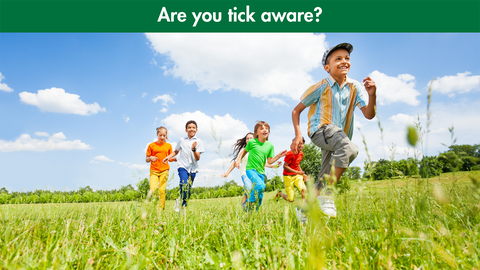THE HIDDEN DANGERS IN UK COUNTRYSIDE
Everyone is quick to think about biting and flying insects like mosquitoes at this time of year. We plan our holidays and prepare as best we can, although each year the UK is the country with the highest number of insect bites. In addition to home-grown problems, our desire to seek international shores for our holidays ensures that we come into contact with mosquitoes that can carry dengue, chikungunya and malaria.
The biggest danger for the majority of us however is in our local parks and countryside in the form of ticks. In the case of London parks, 5 out of 6 ticks have been found to carry Lyme Disease by the London School of Hygiene and Tropical Medicine. Many of us are unaware of both ticks and the diseases they can carry, such as Lyme or Tick borne encephalitis. This may sound dramatic, but for such a serious disease, as a nation, we are highly unaware of the risks.
Cases of Lyme Disease have doubled in the last decade and the British Medical Journal have reported that the actual number of Lyme cases is 3 times what was previously thought. Due to climate change, ticks are more active for longer, through March to end of October
In the UK we seem for the most part to be blissfully unaware of these tiny arachnids which hide in long grass in our parks and countryside. Many adults associate ticks as being a pest to their pets – dogs and sometimes cats can easily pick them up when they are out and about. However, what many people don’t know is that Ticks pose a significant risk to humans. They can carry serious disease, which if left untreated can be life threatening. See BBC report.
Ticks can carry multiple diseases, but Lyme disease is the most common. According to the NHS, ticks infected with the bacteria that causes Lyme Disease have been found in city parks in Europe and North America. Indeed the London School of Hygiene & Tropical Medicine found Lyme in 5 out of 6 Royal London Parks. The UK Health Security Agency says, "On average 2.5% to 5.1% of ticks are infected in England & Wales." It also states, "in the last few years, ticks carrying tick-borne encephalitis virus (TBE) have been found in England. Worryingly, they have also recently confirmed TBE in England." Because of this growing threat the UK government invested £7m of funding to fight ticks earlier this year. It can become a chronic and debilitating illness if left untreated. So regardless of your destination, home or abroad; make sure that you consider the risks of ticks before you pack your bags.
Tick numbers are at an all time high so far this year and we are yet to reach the peak. Rain is beneficial for ticks and more rains mean more ticks. In the UK the majority of people are unaware or blasé about the danger and threat to their well being from ticks. Typically speaking, ticks live in grassy and wooded areas, although they are found in other areas e.g. urban gardens. The number of ticks are growing because of a longer season, due to climate change. Always check your body after walks, dealing with a tick within 24-48 hours can mean the difference between your health and lifelong debilitating disease.

Many people with early symptoms of Lyme disease develop a circular red skin rash around a tick bite. Most rashes appear within the first 4 weeks and usually last for several weeks. However, this rash can appear up to 3 months after being bitten by a tick. The rash is circular in nature and is often described as having a similar appearance to a bulls-eye on a dartboard or target board. However not all Lyme cases present with a rash. Other symptoms include fever and swollen lymph nodes. This combined with the usual painless nature of a tick bite presents a clear need for reliable insect repellent.
This useful mnemonic will help Protect You Against Ticks:
T – Think ticks!
I – Insect repellent is a necessity when out in foliage. Use a PMD-based repellent such as incognito (incognitospray.com)
C – Check your entire body after outings including hidden crevices such as behind the ears and under armpits. Remove any ticks as soon as you can. Ideally within 24-48 hours.
K – Keep to the path. Keep bare flesh covered where possible. Particularly lower abdomen and legs: tuck trousers into socks – your life is more important than fashion!
S – Stick to paths and be alert to symptoms of tick-borne illnesses. The most distinctive symptom of Lyme Disease is a circular red rash resembling a “bulls-eye target”
This advice applies to humans and pets alike. It is shocking the number of animals and people currently being bitten by these arachnids and once the rain stops we will see many more.
The best ways to avoid tick bites are to: use a PMD insect repellent such as incognito on exposed skin; (link to incognito repellents) wear protective clothing with long sleeves and long trousers tucked into socks or boots; and treat socks and trouser legs with permethrin-containing insecticide or spray over clothing with insect repellent.
Ticks prefer warm and moist areas, armpits, groin or scalp, so ensure a thicker layer of repellent is used on these areas, a roll on would be a better solution for underarms etc. Using a citronella hair and body wash will also help.
Get someone to check you after you’ve been out walking for ticks and or puncture marks. Ticks are not easy to spot as they can be smaller than the size of a pin-head. It’s very difficult to feel a tick latching onto your skin; they are easier to spot once they have been feeding for some time and have swollen to the size of a pea.
Unless you know what you're doing, only remove ticks using a special remover.
Tick removal: It’s important to properly remove ticks as soon as they are discovered. Using fine tweezers, or a tick removal device, grasp the tick as close to the skin’s surface as possible and pull upward with steady, even pressure. Avoid twisting or jerking the tick, as this can cause parts of the tick to break off and remain in the skin. The sooner a tick is removed, the less likely disease will be contracted.
Allergic Reactions: Tick bites can cause allergic reactions in some individuals. These reactions can range from mild itching and redness to more severe symptoms that require medical attention.
Secondary Infections: Scratching a tick bite can introduce bacteria from the skin into the wound, potentially leading to secondary infections.
Tick Paralysis: In some cases, certain species of ticks can cause paralysis in both animals and humans. The paralysis typically subsides once the tick is removed.
Transmission to Pets and Livestock: Ticks can also pose significant threats to pets and livestock. They can transmit diseases like Lyme disease, ehrlichiosis, and anaplasmosis to these animals, leading to health issues and potentially impacting their overall well-being.
Preventive Measures: Ticks are often found in grassy, wooded, or brushy areas, and they can latch onto humans and animals when they brush against vegetation. Wearing protective clothing, using insect repellents, and performing thorough tick checks after spending time outdoors can help reduce the risk of tick bites.
Lyme Disease – Symptoms The symptoms of Lyme disease can vary widely and may develop in stages. Here are the common symptoms associated with Lyme disease:
Early Localized Stage (3-30 days after tick bite):
Erythema migranes (EM) Rash: The most distinctive symptom of Lyme disease is the appearance of a circular, red rash that resembles a bull's-eye target. This rash usually appears at the site of the tick bite within 3 to 30 days after the bite. It can expand over time and may be accompanied by central clearing. However, not everyone with Lyme disease develops this rash.
Early Disseminated Stage (weeks to months after tick bite):
Flu-Like Symptoms: Some people may experience flu-like symptoms, such as fever, chills, fatigue, muscle and joint aches, and headache.
Multiple EM Rashes: In some cases, more than one EM rash can develop in different areas of the body.
Neurological Symptoms: These can include facial paralysis (Bell's palsy), severe headaches, and meningitis (inflammation of the membranes surrounding the brain and spinal cord).
Heart Involvement: In rare cases, Lyme disease can affect the heart, causing irregular heartbeats or inflammation of the heart muscle.
Late Disseminated Stage (months to years after tick bite):
Joint Pain and Swelling: Lyme arthritis can develop, resulting in pain, swelling, and stiffness in large joints, particularly the knees.
Neurological Symptoms: Some individuals may experience ongoing neurological symptoms, such as numbness, tingling, shooting pains, and cognitive difficulties.
Other Symptoms: Fatigue, sleep disturbances, and other vague symptoms can persist.
It's important to note that not all individuals with Lyme disease will experience all of these symptoms, and the severity and progression of symptoms can vary widely from person to person. Some people may only experience mild symptoms, while others may develop more severe complications.
If you suspect you have been exposed to ticks and are experiencing any of these symptoms, especially the characteristic EM rash, it's important to seek medical attention promptly. Early diagnosis and treatment with appropriate antibiotics can help prevent the progression of Lyme disease and the development of more serious complications. If left untreated, Lyme disease can lead to chronic health problems affecting various body systems.
Always ensure you have a clinically proven insect repellent with you - especially if travelling in groups and to areas you are unfamiliar with.




Comments (0)
There are no comments for this article. Be the first one to leave a message!